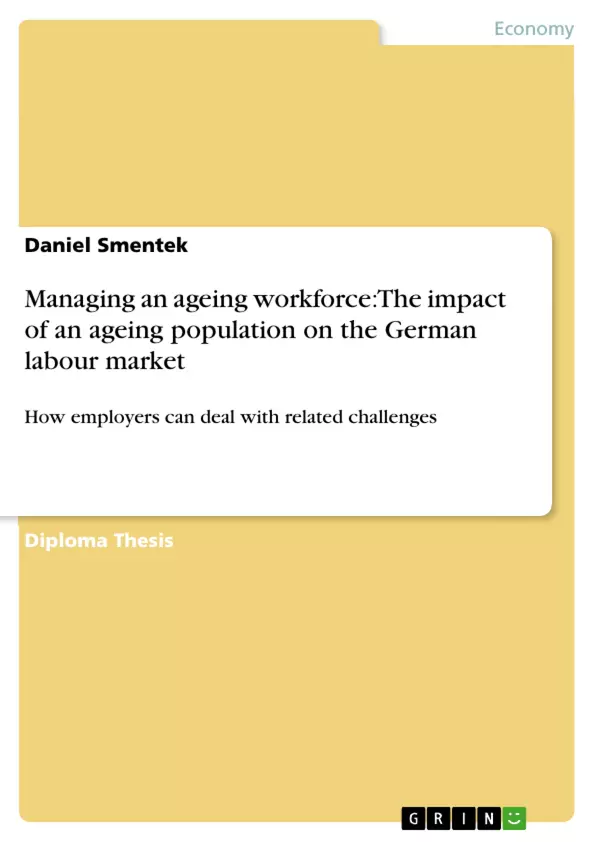Germany’s population, and consequently its workforce is ageing. Fewer young people will enter the workforce and employers will be pressed to draw from an expanding pool of older people. As a consequence the working age population is projected to decline significantly; while the numbers of organisations depended on them will rise. At the same time, baby boomers are moving towards retirement and can not be replaced by middle-aged or younger workers. Facing impending talent shortages and a substantial loss of knowledge and experience, companies might have little choice but to implement new employment strategies. Primarily based on secondary research and supported by available data from various research institutions, this paper considers relevant variables and approaches related to challenges from a German perspective. This is done regardless of specific industry conditions and circumstances. The paper covers selected peripheral issues like attitudes and retirement intentions of older workers and the myths and stereotypes about them. It provides an overview of the German labour market, specifically the situation of older people, and how public policy has been responding to improve related conditions. Finally, minor and major interventions are presented to adapt human resource methods, work arrangements, and framework conditions. Recognising that an effective response to the demographic changes requires a broader perspective, i.e. considering all working generations, the proposed initiatives primarily focus on the attraction and retention of older people.
Inhaltsverzeichnis (Table of Contents)
- Introduction
- The ageing population - European & German trend
- The impact on the German workforce
- Characteristics of an ageing workforce
- Myths and stereotypes
- Benefits to employers
- Attitudes towards retirement
- The German macro-economic environment
- Public pension system
- Employment protection
- Non-wage labour cost
- Level of education
- Legislation on age discrimination
- Further initiatives
- New age management strategy
- The need for change
- Dimensions of good practice
- Workforce planning
- Development of an age neutral culture
- Recruiting and selecting older workers
- Expanding recruiting focus
- Considering new recruiting channels
- Adjusting selection procedures
- Training and career development
- Training opportunities for all ages
- Cross-generational training
- Adapting training programs to older workers
- Providing management training
- Rekindling mature careers
- Alternative work arrangements
- Phased retirement options
- Flexible retirement deals
- Occupational health and safety
- Ergonomic considerations
- Considering sensorial systems
- Preventive health care and rehabilitation
- Implementing new policies
- Ensuring overall commitment
- Involving all generations
- Encouraging knowledge transfer
- Conducting a situational approach
Zielsetzung und Themenschwerpunkte (Objectives and Key Themes)
This paper examines the challenges posed by an ageing workforce in Germany and explores strategies for employers to effectively manage this demographic shift. It draws primarily on secondary research and analyzes available data from various research institutions. The paper aims to provide a comprehensive understanding of the German labour market, specifically the situation of older workers, and how public policy has responded to related conditions. It also presents practical interventions for adapting human resource methods, work arrangements, and framework conditions to create an age-neutral work environment.- The impact of an ageing population on the German labour market
- Challenges and opportunities associated with an ageing workforce
- Strategies for managing an ageing workforce, including workforce planning, recruitment, training, and retention
- The role of public policy in addressing the challenges of an ageing workforce
- The importance of creating an age-neutral work environment
Zusammenfassung der Kapitel (Chapter Summaries)
- Introduction: This chapter sets the stage by introducing the topic of an ageing workforce and its relevance to the German context. It highlights the demographic trends driving this phenomenon and the potential consequences for the German labour market.
- The ageing population - European & German trend: This chapter provides a detailed overview of the ageing population trends in Europe and Germany, highlighting the key factors contributing to these changes and discussing their potential impact on various aspects of society.
- The impact on the German workforce: This chapter explores the specific implications of an ageing population on the German workforce. It examines the projected decline in working-age population, the potential for talent shortages, and the loss of knowledge and experience associated with retiring baby boomers.
- Characteristics of an ageing workforce: This chapter delves into the characteristics of an ageing workforce, addressing common myths and stereotypes, highlighting the benefits that older workers bring to the workplace, and analyzing their attitudes towards retirement.
- The German macro-economic environment: This chapter examines the macro-economic context in Germany, focusing on aspects such as the public pension system, employment protection legislation, non-wage labour costs, education levels, and age discrimination legislation. It analyzes the impact of these factors on the employment of older workers.
- New age management strategy: This chapter presents a comprehensive new age management strategy for dealing with the challenges of an ageing workforce. It explores the need for change, outlines the dimensions of good practice, and provides detailed recommendations for specific interventions, such as workforce planning, recruiting, training, career development, alternative work arrangements, and occupational health and safety measures.
Schlüsselwörter (Keywords)
This research paper focuses on the topic of managing an ageing workforce in the German labour market. It explores key themes such as demographic trends, talent shortages, knowledge transfer, age discrimination, workforce planning, recruitment, training, retention, work-life balance, and public policy. It also analyzes the impact of these themes on the overall competitiveness and sustainability of the German economy.
- Arbeit zitieren
- Diplom-Kaufmann und Bachelor of Commerce Daniel Smentek (Autor:in), 2006, Managing an ageing workforce: The impact of an ageing population on the German labour market, München, GRIN Verlag, https://www.grin.com/document/62000



